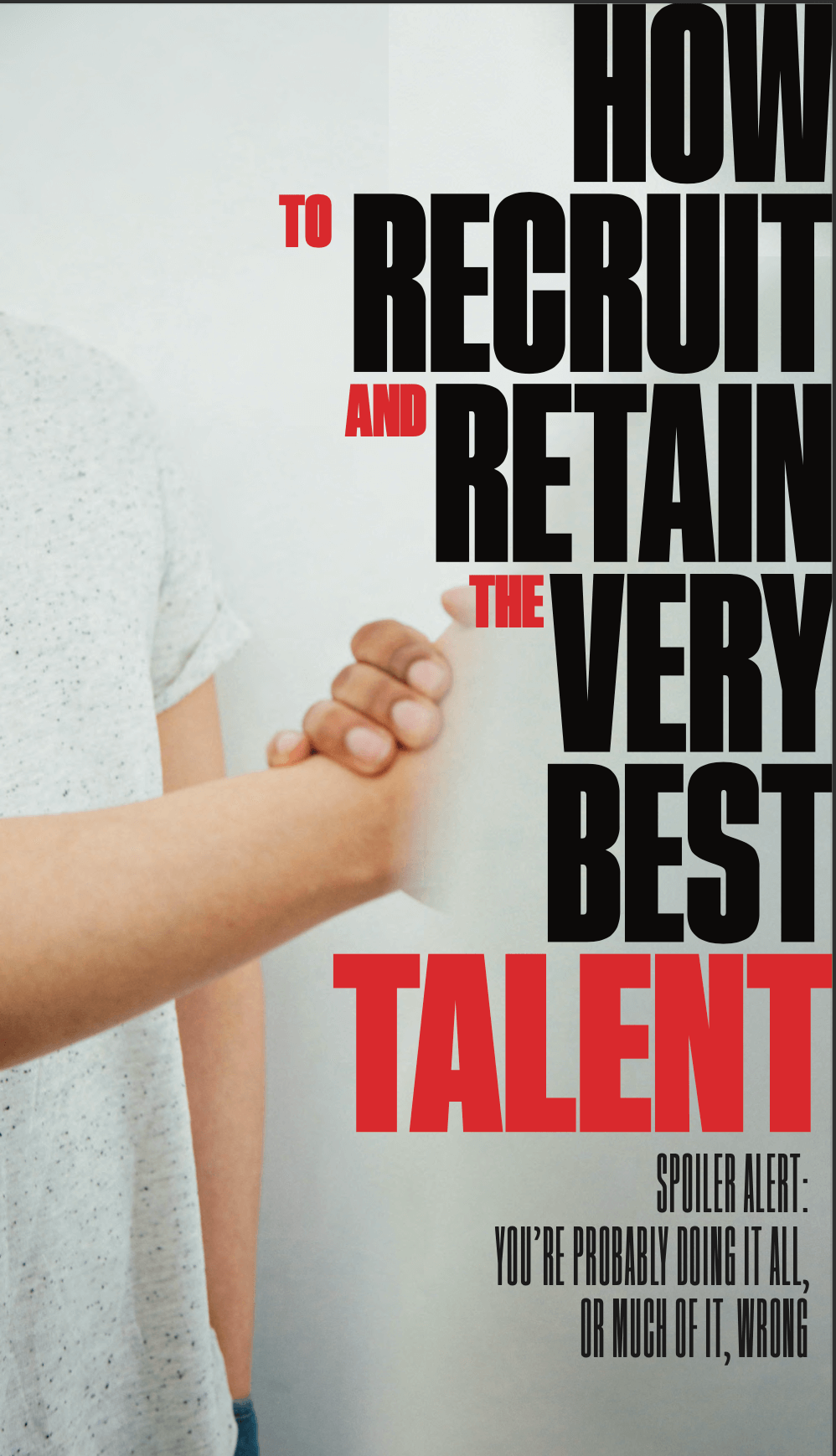
21 Feb How to Recruit and Retain the Very Best Talent
Brace yourself. It’s time to change — and we mean radically change — how you recruit and retain people. What’s worked before doesn’t work anymore. (If you’re honest, you have to admit that the old way never really worked predictably all that well anyway, right?) “Businesses have never done as much hiring as they do today. They’ve never spent as much money doing it. And they’ve never done a worse job of it,” wrote Professor Peter Cappelli, Director of the Wharton Business Schools Center for Human Resources, in The Harvard Business Review.
Everything has changed — the skills we need, the type of people we need, the way they communicate, their needs, their values, the workplace, the pace of change, the ability to predict performance, the availability of data that can take much of the guesswork out of recruiting and retaining, our ability to be flexible about so many things that used to be rigid. The new work environment, the new work force, the new skill sets, and tight job market all force us to make a choice: Change the way we recruit and retain people, or lose potential key hires and essential existing staff to more open, flexible, employee-focused, appealing organisations focused on using data to make their recruiting and retention efforts more predictably successful. We can only succeed in this talent market if we radically reimagine our recruitment and retention practices and polices, and that starts with reimagining our corporate culture.
This change and the others that must follow it will require open minds, flexibility, transparency, new roles, and a willingness to part with comfortable but increasingly ineffective and counter-productive recruitment and retention practices. Here’s an illustration of one of the most important changes you’ll have to be making, one you probably won’t like, one you might initially think is totally bogus: Human analytics. Human analytics is the use of data and data analysis techniques to understand, improve, and optimise the people side of business from recruiting to retention. In terms of recruiting, human analytics has already proven its effectiveness. The US-based National Bureau of Economic Research did a study of 300,000 hires in high-turnover jobs at 15 companies. In those hires, the researchers pitted a hiring process using human experience, instinct, and judgment against a hiring process using a human analytics algorithm.
The result? The homo sapiens were routed. Employees chosen by the algorithms stayed on the job far longer and had performance evaluations equal to or better than those chosen by humans. And that wasn’t the only such study. In a University of Minnesota examination of 17 studies that compared the hiring success rates of algorithms v. humans, the algorithms outperformed humans by at least 25%. “The effect holds in any situation with a large number of candidates, regardless of whether the job is on the front line, in middle management, or (yes) in the C-suite,” according to the study authors. That’s not to say humans weren’t involved in the algorithm-based decisions, but their choices were deeply influenced by the algorithm’s recommendations. Need another push toward human data analytics? How about this: A recent Deloitte report found that organisations using people analytics appropriately reported 82% higher three-year average profit than those who have not yet adopted data analytic strategies or who are not using them correctly. So, are you ready for this new future of recruiting and retention? Let’s start with recruiting.
RECRUITING
First, let’s set the table stakes. The unavailability of talent and skills is only the biggest threat to our businesses, according a recent PwC CEO Survey. Why is talent so important? “Superior talent is up to eight times more productive,” wrote McKinsey Senior Partners Scott Keller and Mary Meaney in their book Leading Organisations. “It’s remarkable how much of a productivity kicker an organisation gets from top talent. A recent study of more than 600,000 researchers, entertainers, politi33 cians, and athletes found that high performers are 400% more productive than average ones. “Studies of businesses not only show similar results but also reveal that the gap rises with a job’s complexity,” Keller and Meaney wrote. “In highly complex occupations — the information- and interaction-intensive work of managers, software developers, and the like — high performers are an astounding 800% more productive.
“Suppose your business strategy involves cross-functional initiatives that would take three years to complete,” they wrote. “If you took 20% of the average talent working on the project and replaced it with great talent, how soon would you achieve the desired impact? If these people were 400% more productive, it would take less than two years; if they were 800% more productive, it would take less than one. If a competitor used 20% more great talent in similar efforts, they would beat you to market even if they started a year or two later. “You get even more remarkable results comparing the productivity of the top and bottom 1%,” wrote Keller and Meaney. “For unskilled and semi-skilled jobs, the top 1% are three times more productive; for jobs of middling complexity (say, technicians and supervisors), 12 times more. One person in the top 1% is worth 12 in the bottom 1%. For high-complexity jobs, the differential is so big it can’t be quantified.”
The late Steve Jobs put it succinctly: “Go after the cream of the cream. A small team of A+ players can run circles around a giant team of B and C players.” There’s not much disagreement about the benefits of hiring the best and the need to do so. Incredibly, there is also almost universal agreement that we aren’t doing a good job. Despite the acknowledged importance of top talent, “a whopping 82% of companies don’t believe they recruit highly talented people,” wrote Keller and Meaney. “For companies that do, only 7% think they can keep it. More alarmingly, only 23% of managers and senior executives active on talent-related topics believe their current acquisition and retention strategies will work.” As we all know, it’s not easy. In many countries around the world, unemployment is low and the people with the skill sets we need are, in many cases, already working for a competitor or in a related industry or at a high tech company. How do we entice them to our media company, especially with the relentlessly negative press our industry has been getting for two decades?

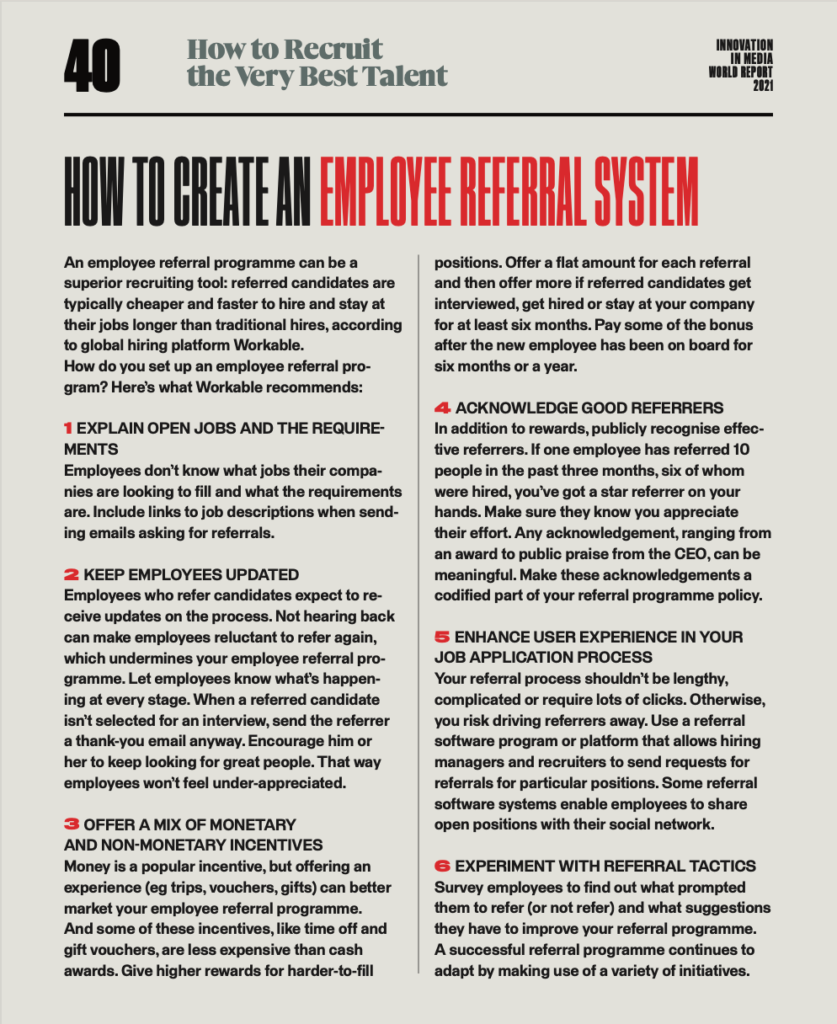
We must make our companies appealing places to work. We must remake our company’s culture to be employee-focused. And then, we must market the hell out of that to attract the people we want. “Good help isn’t hard to find when top talent looks for you,” wrote business author Jim Molis in the US-based Business Journals. That top talent is looking for very specific characteristics and opportunities in the company they would consider joining: A mission they can believe in, a positive culture, stimulating challenges, professional growth, mentorship, competitive pay, rewards for excellence, advancement opportunities, flexible work hours and locations, and more.
“Benefits, location and commute time are increasingly important factors,” CareerBuilder CEO Irina Novoselsky told The Business Journals. “To attract and retain talent, hiring managers will need to meet workers’ hiring, on-boarding and career expectations, and provide the perks, work-life balance and career advancement opportunities they demand.” This is information about your company that shouldn’t take a job interview to discover. You must promote your culture on your website and on social media platforms, using it as a magnet for people looking for great places to work. This takes time and a strategic approach. Here is a multi-step process to spread the word about your terrific company:
1. MAKE SURE your company’s mission and values are appealing, clear, and easily discovered
“Candidates have a better time assessing their fit when you’re clear with your employer brand and values from the outset,” Talent Management Director Kim Stewart of the First Citizens Bank told The Business Journals. “Employees feel more engaged and are more likely to flourish when their values are aligned with those of their employer.” Your mission, and how it impacts customers and employees, should be front and centre on your website. How does your mission come alive for staffers day-in and day-out? How does it challenge them professionally? Demonstrate how you practise your mission in how you treat your employees.
2. CREATE AN employee-focused culture, emphasising individual growth, flexibility
Employees want to be at a company where their work is appreciated and they can make a difference, where their professional growth is actively enhanced, where their work schedules and locations are flexible, where work-life balance is valued, where they are paid competitively, where benefits enhance their lives, and where they have the opportunity for promotions and professional growth. A recent study by talent mobility solutions company RiseSmart found that 84% of employees would consider leaving their current job to move to an employer with a fantastic reputation — even if the salary bump wasn’t that big. Another study found 80% of candidates would choose an employment offer with more flexibility, according to the International Workplace Group.
“That’s a big number, and this is a big advantage for recruiters,” wrote John Dawson, Director of Sales at recruitment tech firm Ideal. “They need to find ways to offer flexibility in different situations: Multiple young children (start/end times for work might need to be adjusted); ageing parents (same, with more remote flexibility); and remote work in general. “If your HQ is in Toronto but the best person for your team is in Denver and they can’t move right now, you should still find a way to bring them into the team,” wrote Dawson. “Don’t sacrifice candidate quality simply because of flexibility or location needs. We have enough technology — think about just Skype or Zoom — where these things can be managed successfully.”
Hiring candidates with non-traditional educational backgrounds has also become increasingly common, Amy Warner, director of talent acquisition at recruitment software company iCIMS, told the Society of Human Relations Management (SHRM). “Recruiters are considering things like self-education, online schooling, certification programmes, and work experience when identifying potential employees. Employers are also investing in more training programmes to groom their own employees to have the skill sets needed to tackle jobs of the future.”

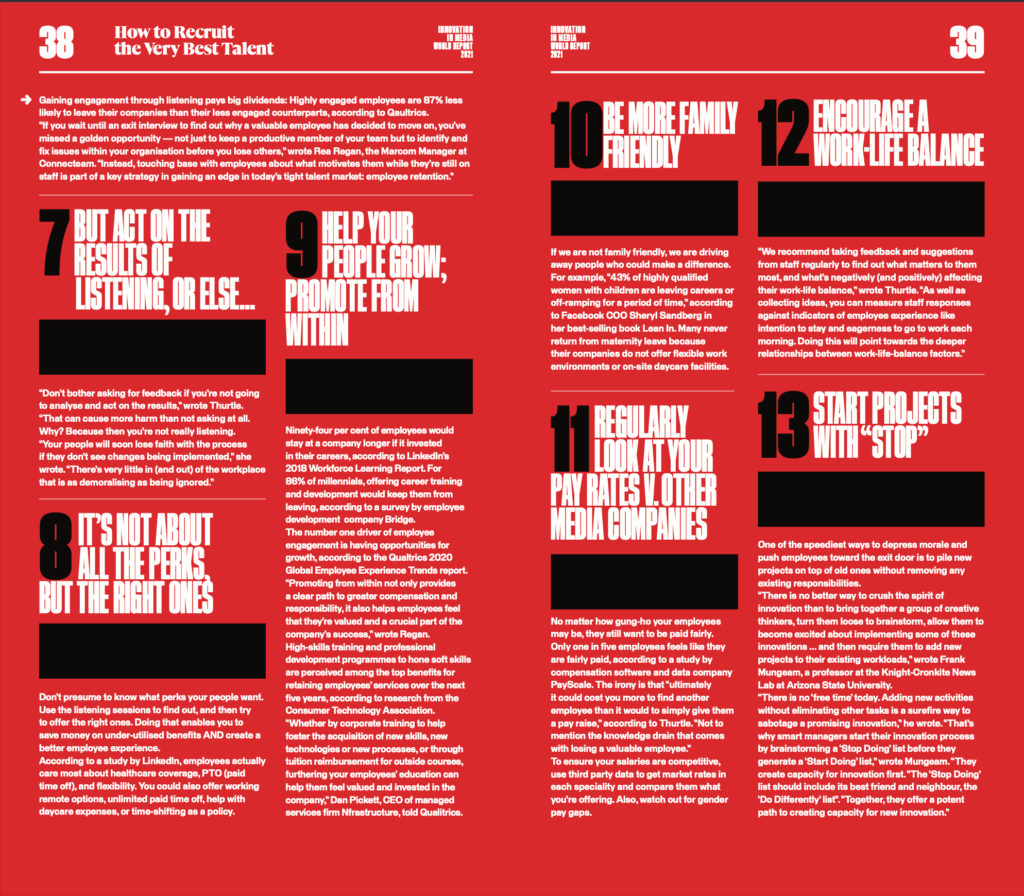
3. GET YOUR best ambassadors involved in recruiting your employees
From a job-seeker’s point of view, the best referral about a company is from a trusted source: A friend or an employee inside an organisation. You can ensure that your staff are great referrals for potential hires by fulfilling task #2: Creating an employee-focused culture. In fixing or enhancing your culture, you will not only be making your company more attractive to potential key hires, but you will also be making your existing employees happier. Happier employees usually stay longer and help you attract the best new hires by showing them that they could be happy there, too. If your staff is happy, they might also be willing to be brand ambassadors and recruit new staff, especially if you show appreciation for their efforts with recognition of some sort, up to and including signing bonuses.
So, before posting your position on job sites and thus opening the floodgates to countless unqualified applicants whose paperwork will consume your HR department’s valuable time, tap in to your company’s built-in chain of connections: Your staff. Create “recruitment cards” touting the company’s attractive culture and the benefits of working there, and hand them out to staffers along with the promise of some sort of reward for steering candidates your way (a cash bonus, gift cards, extra time off, etc.).
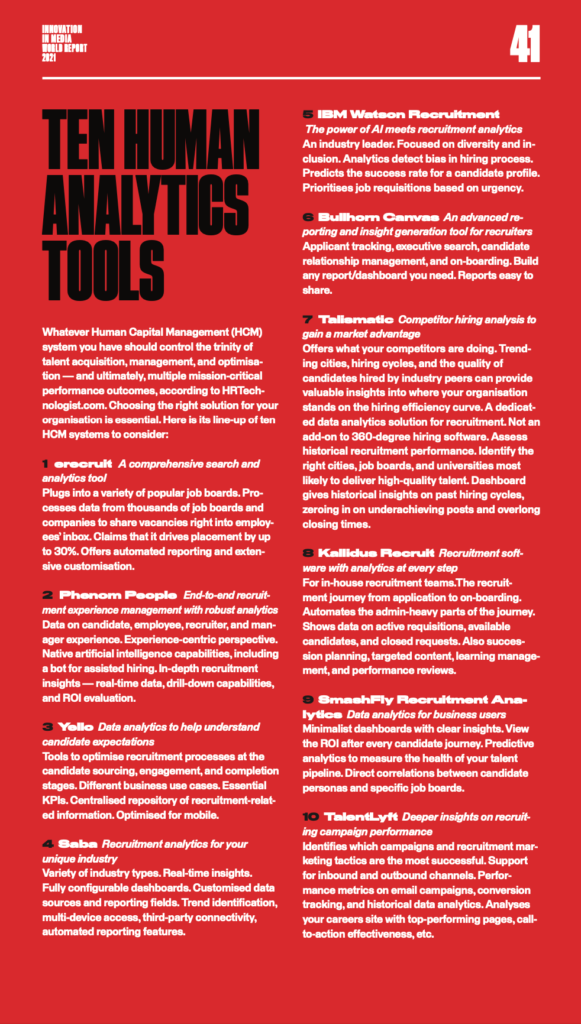
You could also expand your social footprint and get your brand in front of the right talent through content shared by your employees on their own social accounts. “Mobilise your employees into an army of brand ambassadors,” said Allison Kruse, social media director at staffing and solutions firm Kforce. “Consistently deliver content to them in a format that is easy for them to share with their networks. And when employees share content with their networks, they are shaping the perception others have about you as an employer. It will not only exponentially increase your company’s digital footprint, but the content will also perform better because people tend to trust their peers over brands.”
The unspoken and powerful filter in this approach is that no staffer is going to recommend someone who will make them look bad. Everyone will know who recommended the candidate and it’s their reputation on the line. “A downside to referrals, of course, is that they can lead to a homogeneous workforce, because the people we know tend to be like us,” wrote Wharton’s Cappelli. “This matters greatly for organisations interested in diversity.”
MARKETING YOUR COOL NEW COMPANY CULTURE
Now that your company is irresistibly attractive, it’s time to market yourself, whether you’re in the market for new staff or not (actually, you should ALWAYS be looking for great people to build your portfolio of candidates so you’re not scrambling at the last minute and risking having to settle for less due to the pressure of time). But you’re not going to start by taking out ads or doing any other traditional marketing. “With more open jobs than people to fill them and the market at near full employment, recruiters are finding new ways to reach candidates where they are — whether that’s on Instagram or via text,” recruiting software company Jobvite VP/Marketing Matt Singer told SHRM.
“Employers are creating new roles dedicated to recruitment marketing to effectively promote their culture and values and attract wellfit candidates because recruiting is harder than ever before,” Amy Warner told SHRM. “The candidate journey is influenced at every stage by marketing strategies — search engine optimisation, landing page conversion optimisation, digital marketing, content marketing, social media engagement, reputation management,” Lori Sylvia, founder and CEO of Rally Recruitment Marketing, told SHRM. “Recruiters [in HR departments] who fall behind in using digital and social strategies are going to get left behind, not to mention put their employers at a huge disadvantage in the competition for talent.” The top ways companies grow employer brand are through social media (47%) and their careers sites (21%), according to the most recent Recruiter Nation Survey from recruiting tech company Jobvite.
LinkedIn is the most used channel for recruitment efforts, used by 77% of respondents (down from 92% in 2017 with more companies using other sources like Instagram), followed by Facebook (63%). “Recruiters are turning to social media platforms where they know potential candidates are more active,” Jobvite’s Matt Singer said. “This might explain why more recruiters are turning to Facebook and Instagram. Instagram’s popularity with job seekers is increasing its use with recruiters, especially millennial recruiters and those working at technology companies.”
WHAT ARE YOU PUTTING ON YOUR WEBSITE AND ON SOCIAL MEDIA?
“Content has the power to help potential candidates decide whether or not they are a fit for your company,” said Kforce’s Kruse. “Candidates are savvy internet researchers and use a number of sources when searching for jobs and evaluating potential employers.” “By strategically creating and curating content that maps to every stage of the candidate journey, you can answer their questions, provide an inside view into your organisation, tell true stories, and more,” Kruse said. “Companies with a competitive advantage are sharing compelling content (not just posting jobs) that adds value — including why working at their organisation is different from working at similar companies, which helps guide a candidate’s decision to apply or accept an offer,” Kruse explained. “Content can make or break your talent attraction strategy.” But social media is not the end of what you need to be doing differently in marketing your company to potential hires. “If you’re not leveraging technology and in novation in your talent acquisition strategy, you risk being at a competitive disadvantage,” said Karissa Sachs, VP/Digital Strategy at Kforce. “Pixels, chatbots, AI — oh my! In theory, it’s quite simple; how can you get in front of the right candidates, at the right time, with the right message and make it easy for them to apply? Technology will continue to answer this question.”
THEN YOU’VE GOT TO MAKE YOUR MARKETING PERSONAL
Once you’ve identified the best places to go looking for talent, start personalising your campaign, to the point of creating personas to guide your content creation team. “In-demand candidates are beginning to expect a unique and personalised recruiting approach,” said Sachs. “This means that recruitment will have to evolve from a transaction-driven activity to a relationship-building process with an emphasis on providing a highly customised candidate experience. “Similar to how marketers use buyer personas as a representation of a business’s ideal customers, recruiters and talent acquisition professionals can create candidate personas to develop a strategy focused on exactly who you need to hire,” said Sachs.
“From there, a highly targeted recruiting strategy can be developed to identify, recruit and motivate these individuals,” Sachs explained. “What type of content will best resonate with them? How can the job description be optimised to increase application conversion rate? What does their digital footprint look like so that you know where to advertise?” Using data about your own and other professionals in different skill areas, you can include the unique interests typical of these target groups in your recruitment campaign. “A leading IT company once told me that one of their most successful recruitment ads for software engineers called for people who ‘could pull the ears off a gundark’ — an obscure Star Wars reference they knew would resonate with their target group,” said Richard Mosley, VP of Strategy at global talent research firm Universum. “These persona-oriented profiles make it easier to market content to specific target groups, and help you find the right talent.”
TRY TEXTING (SERIOUSLY!)
Everyone in the hiring process appreciates speed: Speedy applications. Speedy replies. Speedy updates. Speedy decisions. There is nothing more speedy than texting. Forty-three per cent of recruiters responding to a Jobvite survey said they have texted candidates and applicants, and 88% report positive feedback from job seekers. “Recruiters and job seekers both value their time, so the need for faster hiring has made text messages and chat even more important than the traditional communication channels like e-mails or phone calls,” Warner said. Meghan McFee, a manager and recruiter for staffing firm WinterWyman’s technology division, slowly began using texts a few years ago, but the option has since become indispensable since her company implemented a texting platform that integrates with her business phone and applicant tracking system. “It’s been terrific for scheduling and quickly getting in touch with people,” McFee told SHRM. “Especially for candidates who are working, it can be very effective in getting a faster response, and it’s gotten great feedback from our recruiters.” Before texting candidates the first time, you should ask permission, she cautioned.
DEFENSIVE MARKETING: WATCH YOUR BACK BY MONITORING (AND NURTURING) REVIEW SITES
In this super-connected world, part of your brand building (or brand destruction) is happening without any input from you… unless you decide to be proactive. While you’re busy marketing your company’s cool new culture on Facebook, LinkedIn, and Instagram, your target candidates are cruising anonymous employer review sites to see what life is like inside your company. Seventy-five per cent of recruiters told Jobvite that Glassdoor reviews are very or somewhat important in the hiring process. “While consumer brands quickly realised the power of reviews as either third-party endorsements or sound chambers for services and product features that needed fixing, employers have been a little slower to adopt this mindset,” Christopher Kurtz , CEO of employment brand PeerThru, told SHRM. “This can be especially true in companies that are run by executives who are not digital natives and have yet to fully realise the value of the insights and feedback being delivered for free.” Third-party sites like glassdoor.com now offer staffers, former staffers, and job applicants the opportunity to rate your company on all sorts of criteria, from overall reviews to specific topics such as salaries, benefits, and job interviews. Employees or former employees get to give your company a star ranking (from 1-5), rate the CEO, and answer the question: “Would you recommend the company to a friend?”. The respondents range from entry-level to top management. Applicants get to rank the interview process. The results are revealing and, too often, disturbing and damaging. Here are some random examples of Glassdoor rankings of several publishing companies (these numbers were gathered in late December 2019):
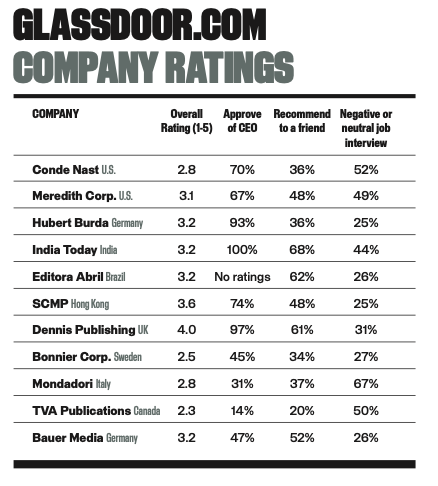
Would you agree that all but a few of those companies have a problem? If you were approached by a recruiter to work at one of the companies where only 34-37% or just barely 50% of the staff reviewers would recommend the company to a friend, would you even bother with an interview? Those companies might be doing a slam-bang marketing job and spending a good deal of time and money on a branding campaign to convince potential employees what a great place it is to work. But all that work is eviscerated by these ratings, cutting the legs right out from under any PR campaign. It’s not all bad news: Those rating numbers aren’t just static grades with no context. Each current or former staffer or job candidate who writes a review ends it with a list of pros and cons, followed by their “Advice to Management”. Sure, some are negative and nasty, but some suggestions are solid and give managers
a clear picture of how they could improve their culture, conditions, benefits, training programmes, communication, etc. Free advice! So, if you aren’t aware of these sites, you could be getting stabbed in the back, undermined by unhappy employees or scorned applicants, and not even know how badly your marketing efforts are being torpedoed. (See sidebar on “Employee review sites you need to know about”.)
HOW DO YOU WATCH YOUR BACK?
PeerThru’s Kurtz suggests the following fourstep process:
1. Follow your profiles on Glassdoor, Indeed etc. and sign up to receive notifications of reviews as they come in.
2. Develop a plan for responding to reviews both internally and externally. “Having a plan helps take the guesswork out of which reviews need to be triaged immediately and by whom, and which are OK to let simmer,” Kurtz said. “And remember, if people outside of your company are reading reviews, your employees are likely reading them as well.”
3. Encourage more reviews by addressing and responding to them, not just by asking for them. “Blanketing the company with a request for reviews is not a good idea,” Kurtz said. “People by nature are suspicious. Asking for specifically positive reviews is fundamentally flawed.” You could talk to your employees about how valuable those reviews can be for potential new hires and suggest that if they are comfortable adding their reviews, you’d appreciate it.
4. Other traps include trying to respond to every review or engaging in shady practices for gathering reviews. “Don’t offer bribes for positive reviews,” Kurtz said. “Along those same lines, do not pay a third party to write positive reviews for you.”
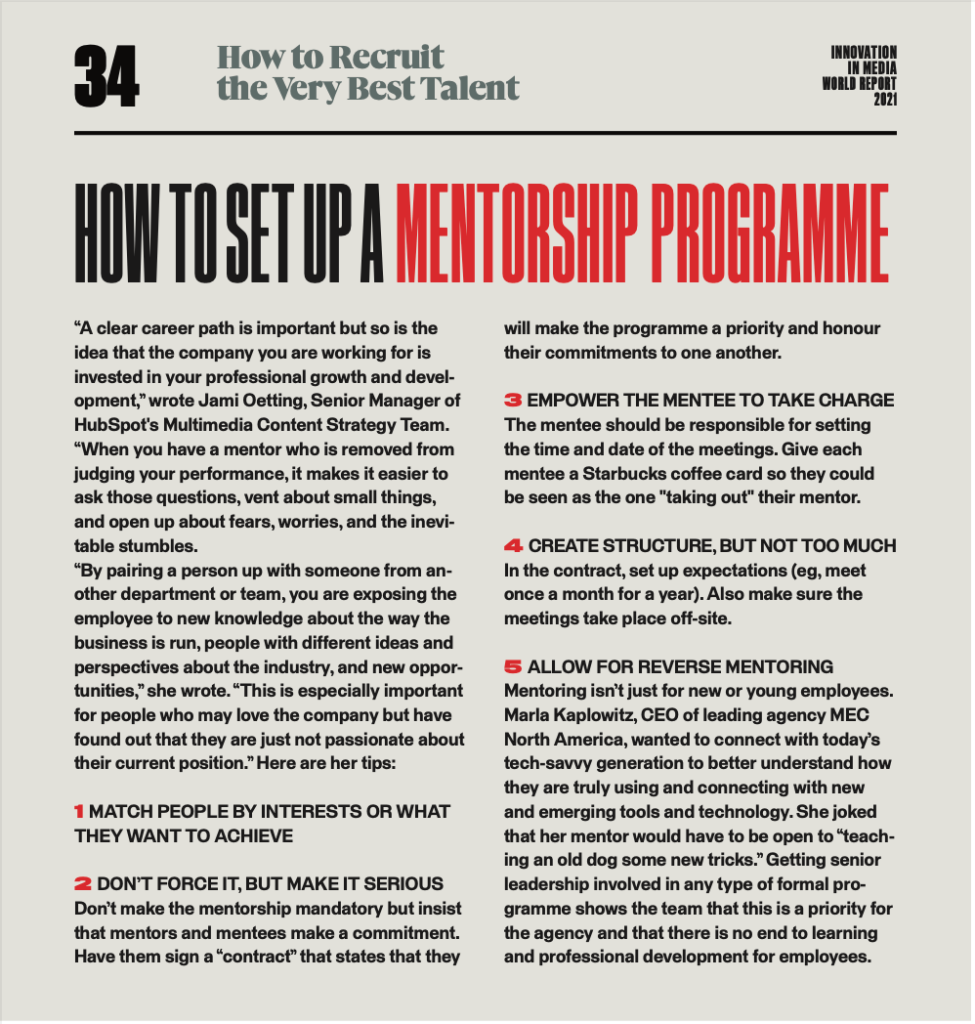
HUMAN ANALYTICS: WHAT ARE THEY AND HOW SHOULD YOU USE THEM?
One of the fastest-growing trends in the HR world today is known as “people analytics,” or the data analysis techniques applied to understanding and improving processes that affect employees, job-seekers, performance management, and everything human capital, wrote Isabella Lazzareschi, Content and Managing Editor at education tech company Degreed. “When specifically applied to hiring, people analytics can help save you money, increase efficiency, and cut down on wasted time on recruitment efforts,” she wrote. Here is her list of what human analytics can do for a company in terms of recruitment alone:
Assess which talent pipelines are most successful, so you can appropriately allocate spending to optimise successful recruitment
Identify recruitment cycles to help determine when to spend money actively searching for candidates and when to slow down
Analyse market rates to remain competitive in recruiting and retaining top talent
Keep a pulse on your current employees to examine racial, ethnic, and gender diversity in your existing workforce to ensure you’re offering equal opportunities to all
“When applied to the hiring process, data analytics can remove human biases by isolating objective traits in applications and identifying candidates with appropriate backgrounds,” wrote Lazzareschi.
“And beyond just minimising prejudice, proper analysis tools can actually promote diversity within your company by finding applicants with appropriate skill sets, but atypical backgrounds or work experiences. This is along the lines of hiring for a ‘culture-add’ rather than a ‘culture-fit’, but using more direct techniques to ensure you’re finding the best candidate for the job.”
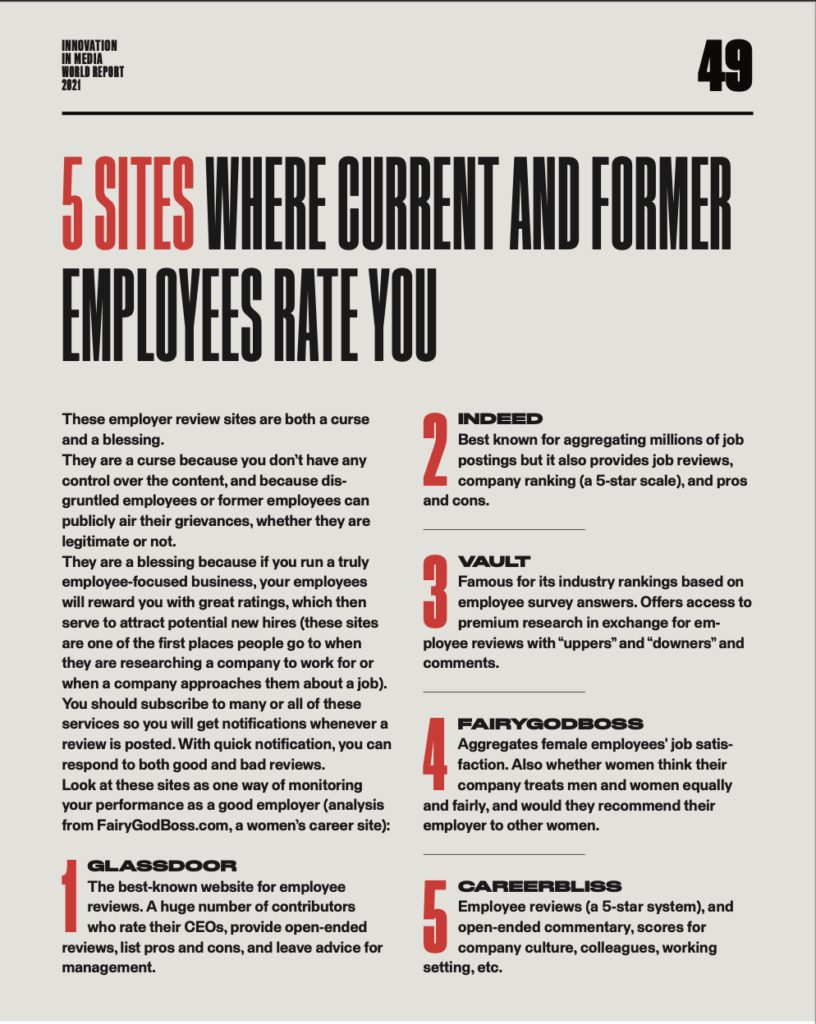
WHAT’S CAUSING THE RISE IN THE USE OF DATA ANALYTICS?
The rise in the use of analytics has been caused by three main factors, according to Ideal, an artificial intelligence-focused talent system company: 1. Improvements in technology and software has caused an explosion in data and data analytics. This adoption has been seen recently in the transformation of sales and marketing departments. 2. The need for measurable outcomes: HR departments are increasingly being asked to justify their decisions based on measurable outcomes. This has led to the push for business decisions to be made based on analytics and data rather than just using gut instinct and subjective judgment. 3. The stunning rise in the collection of staff data: Most HR departments are sitting on mountains of data about their employees including demographic data, performance data, job history, compensation, and training. Until recently, this data had yet to be effectively and strategically leveraged.
THREE MAIN TYPES OF TALENT-RELATED DATA THAT CAN BE ANALYSED, ACCORDING TO IDEAL, ARE:
1. People data such as demographics, skills, and engagement.
2. Programme data such as attendance, adoption, participation in training and development and leadership programmes, and outcomes of key projects and assignments.
3. Performance data such as performance ratings and data captured from the use of instruments such as 360 assessments and succession programmes. “Recruitment analytics is defined as the use of statistical models to make sense of the vast amount of data collected across the hiring process, enabling meaningful data-driven recruitment,” according to HRTechnologist.com.
“You could have historical analytics (generating insights from past data), real-time analytics (in the moment notifications and alerts), predictive analytics (measuring future possibilities), and prescriptive analytics (suggesting the way forward),” according to HRTechnologist. Research suggests that most companies are still using inefficient recruitment processes. Ac-
cording to HRTechnologist, data analytics can:
Provide valuable insights on which talent sources are performing the best, the effectiveness of internal versus external hiring, and any preventable costs incurred.
Redefine the candidate experience by pinpointing problem areas and high-performing touch-points along the way.
Refine your talent acquisition and recruitment strategy to the point where each recruitment effort is productive and optimised for measurable results. Research featured in The Harvard Business Review found that using an algorithm increases the ability of recruiters to find the best qualified candidates by more than 50%.
The benefits of human analytics to recruitment include:
Reducing time-to-hire by replacing manual processes
Increasing quality of hire by avoiding unconscious biases early in the hiring process
Collecting recruiting and hiring data that can be correlated with business outcomes such as increased revenue
“Of course, the final hiring decision will always come down to a human, but data and analytics can save a lot of time by narrowing the field down from maybe hundreds of candidates to the most suitable 10 or 20,” wrote business author Bernard Marr on Forbes.com. “This automation of certain processes frees up the HR team to focus on other activities.” Analytics have also shown downstream benefits in HR:
Attrition rates decreased by 35%
Performance increased by 20%
Revenue per employee improved by 4%
It would not be surprising to know that some HR departments resist using data-based recruiting methods for fear of having their expertise questioned. And there are concerns about the fast-growing field. “A problem with machine learning approaches is that few employers collect the large volumes of data — number of hires, performance appraisals, and so on — that the algorithms require to make accurate predictions,” wrote Wharton School Professor Cappelli. “Although vendors can theoretically overcome that hurdle by aggregating data from many employers, they don’t really know whether individual company contexts are so distinct that predictions based on data from the many are inaccurate for the one.

“Another issue is that all analytic approaches to picking candidates are backward looking, in the sense that they are based on outcomes that have already happened,” he wrote. “As Amazon learned, the past may be very different from the future you seek. It discovered that the hiring algorithm it had been working on since 2014 gave lower scores to women because historically the best performers in the company had disproportionately been men. So the algorithm looked for people just like them. Unable to fix that problem, the company stopped using the algorithm in 2017. Nonetheless, many other companies are pressing ahead.” Even if you use human analytics (and make accommodations for the above-cited weaknesses), you still need human beings to exercise their judgment and expertise to carefully analyse the data, to put it in the context of the company and the particular job, and then to decide how to use the data. Human critical thought and analysis cannot be replaced by algorithms, just enhanced by them.
Remember when we talked about crafting your mission and culture statements to make your company appealing to potential recruits. Data can help there, too. In creating your mission and culture statements, you want to answer the questions: l What do you want your company to stand for? l How do you want employees to feel about working for the company? l What makes you different from other employers? Once you have your vision, you can use data and analytics to determine if your brand image actually matches the reality of the experience of working at your company. “You can, for example, conduct sentiment analysis on interview and survey responses and social media posts to establish how success know how to quantify and measure it — and perhaps most importantly, to frame their strategy around those insights — will beat their competi – tion in the war for talent,” said KForce’s Sachs. “Using tools that produce valuable feedback enables organisations to identify areas of im – provement throughout the candidate experi – ence, allowing them to strategise a plan to become an employer of choice,” she wrote.
MEASURE, MEASURE, MEASURE… AND ANALYSE
“Few employers know which channel produces the best candidates at the lowest cost because they don’t track the outcomes,” wrote Whar – ton’s Cappelli. “Monitor recruiting channels and employees’ performance to identify which sources produce the best results. “It’s impossible to get better at hiring if you can’t tell whether the candidates you select become good employees,” he wrote. You must measure which hiring practices and platforms produce the best employees. “Why is that not getting through to companies?” asked Cappelli. “Surveyed employers say the main reason they don’t examine whether their practices lead to better hires is that measuring employee performance is difficult.
Surely this is a prime example of making the perfect the enemy of the good. Some aspects of performance are not difficult to measure: Do employees quit? Are they absent? Virtually all employers conduct performance appraisals. If you don’t trust them, try something simpler. Ask supervisors, ‘Do you regret hiring this individual? Would you hire him again?’” “Organisations that don’t check to see how well their practices predict the quality of their hires are lacking in one of the most consequential aspects of modern business,” he concluded. RETAINING It’s a human capital double whammy. In addition to the massive recruitment challenge, media companies are also facing an employee retention crisis. More employees than ever before are voluntarily leaving their jobs. In the United States, for example, the most workers since 2001 — 3.58 million or 2.4% of the workforce — quit their jobs in July 2019, according to the Job Openings and Labor Turnover Survey.
That’s almost 115,484 a day. Or almost 4,812 an hour! In the U.S. alone. What’s going on? At least five forces are at work:
1. A strong labour market. In many countries, there are more skilled job openings than there are people with those skills.
2. Poaching: Census data shows, for example, that the majority of people who took a new job last year weren’t searching for one: Somebody came and got them.
3. Employee dissatisfaction: Half of all employees feel like they only have jobs, not careers, and 32% of all employees plan to leave their jobs before the end of 2020, according to a recent CareerBuilder survey.
4. Greater job mobility: Related surveys report that 73% of employees are “thinking about another job” and that 43% were more likely to consider a new one than they had been a year earlier.
5. Lack of loyalty: Millennials are far less loyal to their employers than their parents were. In the U.S., the Bureau of Labor Statistics reported that workers now stay at each job, on average, for 4.4 years, but the average expected tenure of the youngest workers is about half that. Why is retention so important? “People often underestimate the cost of turnover: the more information- and interaction-intensive the job, the greater the threat to productivity when good people leave it, and the more time and money must be invested in searching and on-boarding,” wrote McKinsey’s Keller and Meaney.
“And if competitors poach your talent, they get an insider’s understanding of your strategies, operations, and culture. “And the scarcer top talent becomes, the more companies that aren’t on their game will find their best people cherry-picked by companies that are,” they wrote. In addition to the time and effort of hiring, Wharton Business School Professor Matthew Bidwell found that outside hires take three years to perform as well as internal hires in the same job, while internal hires take seven years to earn as much as outside hires are paid, wrote Professor Cappelli.
Bidwell also found that outside hiring also causes current employees to spend time and energy positioning themselves for jobs elsewhere, wrote Cappelli. “It disrupts the culture and burdens peers who must help new hires figure out how things work.”
THE VERY SERIOUS COSTS OF NOT RETAINING YOUR BEST PEOPLE
According to the Work Institute’s Retention Report, 75% of those people who resigned from their role could have been retained. The cost of not retaining them: From 90% to 200% of annual salary. “The true cost might even be higher due to training/on-boarding, lost productivity, recruitment, and decreased morale among other employees,” according to a report by the enterprise analytics and mobility software company Microstrategy. “Losing an employee that’s in the top 1% of performers could mean the difference between growth and decline.”
CAN DATA COME TO THE RESCUE HERE, TOO?
As in recruiting, human analytics can help with retention: According to Microstrategy and Keller and Meaney, HR analytics can help improve retention through churn analyses that look at data points like:
Current churn rate
Attrition by department
Attrition by estimated commute time
Participation in training and development
Similar attributes of employees with longer tenure
Outcomes of key projects and assignments
Similar attributes of employees who leave within one year
On-boarding experience
Attendance
Skill sets
Performance ratings
360 assessments
Survey data
Qualitative data such as employee inter views
Employee performance data to forecast future attrition
“Through this data-driven approach, HR analytics can illuminate the major causes of attri – tion, and new policies, along with training programmes, can be put in place to help mitigate the problem,” according to Microstrategy. “For example, data might show that high-aspiration employees are not challenged or employees are frustrated with a certain management style. “Human resources analysis will reveal these issues, and then it will be up to leadership to act,” they wrote. “It’s also possible to spot an at-risk employee before they leave, so preemptive ac – tions can be taken to resolve issues. For example, a once high-performer may not be as produc – tive because he feels he or she is underpaid.
An analysis of productivity alongside a comparison of market-value salaries can help spot this.” On a macro scale, Glassdoor Chief Economist Andrew Chamberlain, Ph.D., examined data from 5,000 job transitions from a sample of thousands of resumes on Glassdoor from 2007 to 2016. Some moved to a new role at the same company while others moved to a new employer.
“By combining the data on real-world job transitions with Glassdoor company ratings and salary information, we were able to pinpoint which statistical factors push workers out the door and which motivate employees to stay and grow in their existing organisation,” Chamberlain wrote in the Harvard Business Review. “We looked at how job turnover correlated with pay, company culture, how long an employee has been in their current job, what industry they’re in, and more.
“Candidates who have stagnated in roles for a year or more are statistically more likely to be receptive to recruiter inquiries than candidates who are rapidly climbing their company’s career ladder,” he wrote. “Workers who don’t see a clear progression from their current role to a better position in their company ultimately turn to opportunities elsewhere. And that suggests an easy solution. By providing clear paths for employees, moving them through job titles on a regular progression over time, employers can help boost perceived career opportunities and limit this type of harmful stagnation.” “And candidates whose current employers have low culture ratings or who are underpriced relative to the market are statistically more likely to consider offers at new employers,” wrote Chamberlain. “When employees switch employers, we find they usually move to companies with higher Glassdoor ratings.


